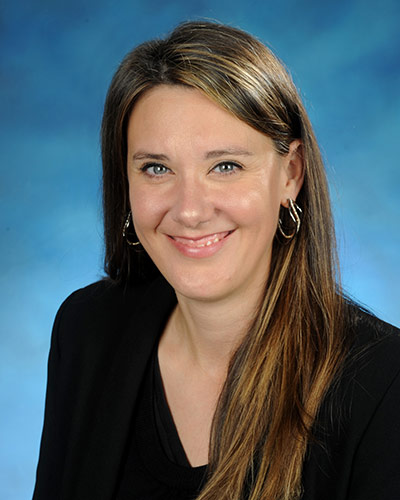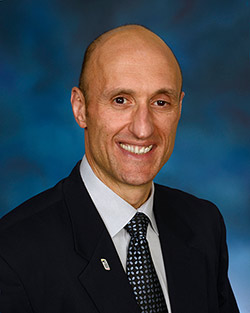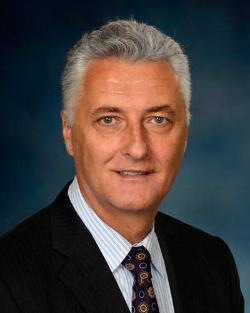October 14, 2021

 William F. Regine, MD, FACR, FACRO, Professor and Isadore & Fannie Schneider Foxman Chair of UMSOM’s Department of Radiation Oncology, has announced the promotion of Isabel Lauren Jackson, PhD, to the position of Director of the department’s Division of Translational Radiation Sciences (DTRS). Dr. Jackson, the Marlene & Stewart Greenebaum Professor in Radiation Oncology, previously served as that division’s Deputy Director and Director of the Medical Countermeasure Program (MCP).
William F. Regine, MD, FACR, FACRO, Professor and Isadore & Fannie Schneider Foxman Chair of UMSOM’s Department of Radiation Oncology, has announced the promotion of Isabel Lauren Jackson, PhD, to the position of Director of the department’s Division of Translational Radiation Sciences (DTRS). Dr. Jackson, the Marlene & Stewart Greenebaum Professor in Radiation Oncology, previously served as that division’s Deputy Director and Director of the Medical Countermeasure Program (MCP).
 “Given Dr. Jackson’s formidable ability to advocate for DTRS and its ultimate vision of benefitting cancer patients worldwide, she is the perfect choice to oversee and guide this division’s growth and success,” said Dr. Regine. “I am confident that she will bring continued vigor and unprecedented academic and scientific success to our department’s radiation research activities.”
“Given Dr. Jackson’s formidable ability to advocate for DTRS and its ultimate vision of benefitting cancer patients worldwide, she is the perfect choice to oversee and guide this division’s growth and success,” said Dr. Regine. “I am confident that she will bring continued vigor and unprecedented academic and scientific success to our department’s radiation research activities.”
Dr. Jackson, who joined the Department of Radiation Oncology in 2012, is a dynamic researcher and educator who has brought international attention and significant funding to the USMOM in advancing radiation countermeasures. As a leader in laboratory development and management, she has worked with Zeljko Vujaskovic, MD, PhD, Professor of Radiation Oncology and the department’s Vice Chair for Research, to create new models for extramural support. As MCP Director, Dr. Jackson strategically developed the organizational structure, recruited talent, and secured funding to build the scope and reputation of the program into the premier site for medical countermeasure research, managing all aspects of study execution while overseeing a faculty and staff of 70 individuals. The division currently has a funding portfolio of more than $50 million, including significant funding from the federal government’s Biomedical Advanced Research and Development Authority (BARDA) and the National Institute of Allergy and Infectious Diseases (NIAID), among others. Most recently, she wrote and coordinated submission of the proposal that led to MCP’s designation as a NIAID/NIH Center for Medical Countermeasures against Radiation (an award of more than $12 million plus options), along with a sustaining award from BARDA (more than $7 million) to ensure continuation of essential translational research activities during the pandemic.
 In her new role, Dr. Jackson will direct a division dedicated to tackling the most important challenges in clinical radiotherapy and life-threatening radiation exposures. DTRS was established by Drs. Vujaskovic and Jackson to accelerate the discovery and clinical implementation of new therapeutic strategies to improve tumor response in clinical radiotherapy, minimize post-radiation therapy complications, and treat the life-threatening health effects of a radioactive or nuclear agent. To accomplish its mission, research within the Division is focused on bridging the gap between novel hypothesis-driven science and contract research services to advance new drugs, medical devices, and therapeutic techniques from preclinical efficacy studies toward clinical trial for radiation oncology and biodefense applications. In doing so, the Division provides a comprehensive set of services to the U.S. government and to pharmaceutical, biotechnology, and medical device companies in the areas of medical and radiation oncology, radiation biology/physics, and biodefense.
In her new role, Dr. Jackson will direct a division dedicated to tackling the most important challenges in clinical radiotherapy and life-threatening radiation exposures. DTRS was established by Drs. Vujaskovic and Jackson to accelerate the discovery and clinical implementation of new therapeutic strategies to improve tumor response in clinical radiotherapy, minimize post-radiation therapy complications, and treat the life-threatening health effects of a radioactive or nuclear agent. To accomplish its mission, research within the Division is focused on bridging the gap between novel hypothesis-driven science and contract research services to advance new drugs, medical devices, and therapeutic techniques from preclinical efficacy studies toward clinical trial for radiation oncology and biodefense applications. In doing so, the Division provides a comprehensive set of services to the U.S. government and to pharmaceutical, biotechnology, and medical device companies in the areas of medical and radiation oncology, radiation biology/physics, and biodefense.
“My goal over the past nine years has been to focus on developing an agile and sustainable animal model framework and talent infrastructure for development of Medical Countermeasures from discovery to approval under the U.S. Food and Drug Administration Animal Rule regulatory pathway. We’ve built productive partnerships with both government and drug companies that are working in this area to improve the medical management of individuals acutely exposed to radiation in a nuclear incident ,” said Dr. Jackson.
Looking ahead, Dr. Jackson sees an expanded potential for DTRS. “My goal over the upcoming years is to leverage the infrastructure we’ve established to expand our programs in tumor radiobiology and clinically relevant normal tissue injury to improve the therapeutic ratio in cancer treatment,” she noted. “As the number of cancer survivors grows, long-term quality of life has become a primary outcome measure secondary only to survival. The added value of the government and industry investment in medical countermeasures is to translate these new therapeutics to reduce side effects in cancer patients undergoing radiation therapy.
“In collaboration with our Cancer Center colleagues, the Division is identifying new therapeutic targets in cancer biology and investigating new multimodality therapies to improve cancer cure rates. I am excited about what the future holds and our faculty contributions to advancing radiation therapy in the 21st century,” she said.
 Albert Reece, MD, PhD, MBA, Executive Vice President for Medical Affairs, UM Baltimore, and the John Z. and Akiko K. Bowers Distinguished Professor and Dean, University of Maryland School of Medicine, commented: “This is tremendous recognition for the integral role that Dr. Jackson has played in the dramatic growth of the DTRS research portfolio in recent years. Dr. Jackson has been one of our rising stars and is now truly wonderfully recognized as one of our most prolific and successful leaders in this very complex and challenging area of scientific study.”
Albert Reece, MD, PhD, MBA, Executive Vice President for Medical Affairs, UM Baltimore, and the John Z. and Akiko K. Bowers Distinguished Professor and Dean, University of Maryland School of Medicine, commented: “This is tremendous recognition for the integral role that Dr. Jackson has played in the dramatic growth of the DTRS research portfolio in recent years. Dr. Jackson has been one of our rising stars and is now truly wonderfully recognized as one of our most prolific and successful leaders in this very complex and challenging area of scientific study.”
About the University of Maryland School of Medicine
Now in its third century, the University of Maryland School of Medicine was chartered in 1807 as the first public medical school in the United States. It continues today as one of the fastest growing, top-tier biomedical research enterprises in the world -- with 46 academic departments, centers, institutes, and programs, and a faculty of more than 3,000 physicians, scientists, and allied health professionals, including members of the National Academy of Medicine and the National Academy of Sciences, and a distinguished two-time winner of the Albert E. Lasker Award in Medical Research. With an operating budget of more than $1.2 billion, the School of Medicine works closely in partnership with the University of Maryland Medical Center and Medical System to provide research-intensive, academic and clinically based care for nearly 2 million patients each year. The School of Medicine has nearly $600 million in extramural funding, with most of its academic departments highly ranked among all medical schools in the nation in research funding. As one of the seven professional schools that make up the University of Maryland, Baltimore campus, the School of Medicine has a total population of nearly 9,000 faculty and staff, including 2,500 students, trainees, residents, and fellows. The combined School of Medicine and Medical System (“University of Maryland Medicine”) has an annual budget of over $6 billion and an economic impact of nearly $20 billion on the state and local community. The School of Medicine, which ranks as the 8th highest among public medical schools in research productivity (according to the Association of American Medical Colleges profile) is an innovator in translational medicine, with 606 active patents and 52 start-up companies. In the latest U.S. News & World Report ranking of the Best Medical Schools, published in 2021, the UM School of Medicine is ranked #9 among the 92 public medical schools in the U.S., and in the top 15 percent (#27) of all 192 public and private U.S. medical schools. The School of Medicine works locally, nationally, and globally, with research and treatment facilities in 36 countries around the world. Visit medschool.umaryland.edu
Contact
Office of Public Affairs
655 West Baltimore Street
Bressler Research Building 14-002
Baltimore, Maryland 21201-1559
Contact Media Relations
(410) 706-5260
Related stories

Tuesday, November 17, 2020
UMSOM's Department of Radiation Oncology Announces New Endowed Professorship and Senior Leadership Appointments in the Department
University of Maryland School of Medicine (UMSOM) Department of Radiation Oncology Chair William F. Regine, MD, FACR, FACRO, along with UMSOM Dean E. Albert Reece, MD, PhD, MBA, announced today that three prominent faculty members in the Department of Radiation Oncology will be promoted into leading department positions that recognize their outstanding academic scholarship and success.
